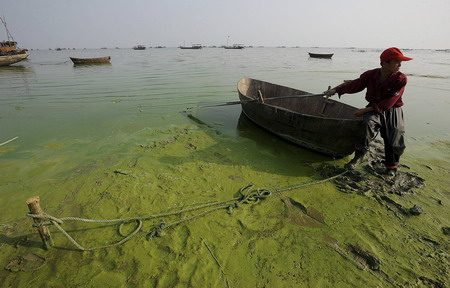
|
|
A fisherman pulls a boat at the algae-filled Chaohu Lake in Hefei, Anhui province, May 1, 2008. Blue-green algae has been discovered in Chaohu Lake, which is China's fifth largest body of fresh water and the drinking water source for about 320,000 people, an environmental official said. [Xinhua]

|
Blue-green algae has been discovered in Chaohu Lake, which is China's fifth largest body of fresh water and the drinking water source for about 320,000 people, an environmental official said.
The lake in Anhui Province has been severely polluted in recent months.
Following a long stretch of hot, dry weather, patches of algae were found in the western part of the lake, and traces of algae also cropped up in the eastern part, said Xiao Pu of the Anhui environmental protection bureau. Xiao said the lake supplies drinking water to about 320,000 people on its eastern banks.
"Normally, algae need a proper proportion of nitrogen and phosphorus, continuous temperatures above 25 degrees centigrade and strong sunlight for at least three days," to thrive, Xiao said. "Although there are no signs of a massive bloom of algae in the lake, current conditions are conducive to algae growth."
Xiao attributed the situation to the heavy snowfalls early this year. "When the snow melted, the water carried fertilizers and other nutrient runoffs to the lake, bringing the volume of nitrogen and phosphorus to a higher level."
The provincial environmental authority has ordered local environmental officials to enhance monitoring of the lake and plan for alternative water supplies.
Chaohu Lake, which covers 13,000 square kilometers, became increasingly polluted after nearby cities industrialized and the wetland was destroyed.